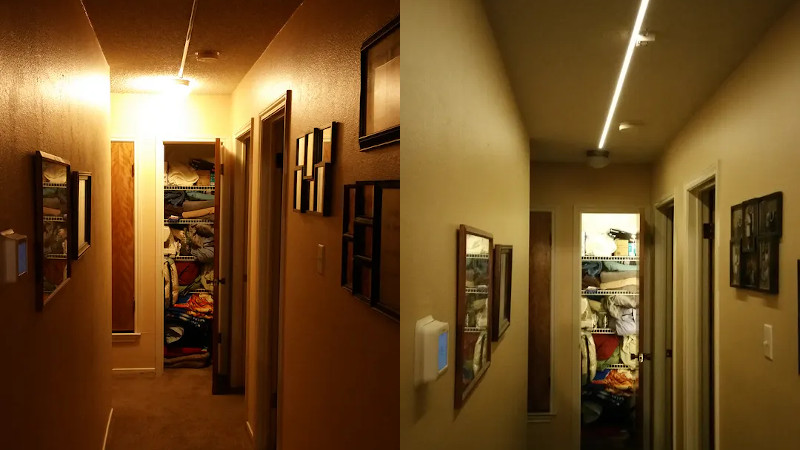There’s nothing worse than a lightswitch that’s nowhere near where it should be, leaving you fumbling around in the dark. [supersquirrel72] had just this problem, and decided to put an Arduino to work instead.
Rather than using the original mains lighting that was poorly positioned and not enough to light the hall, instead 2 meters of white LED strip was chosen. The form factor is perfect for lighting a long, thin space – far better than running a series of seperate bulbs. The strip was rigged up to an Arduino Uno, that triggers the lights when movement is detected with a simple PIR motion sensor. After some feedback from the other occupants of the house, it was decided to tweak things further. An RTC was implemented to allow the Arduino to keep things dimmer after 9PM, so as to not wake others when making a trip to the kitchen for a midnight snack.
It’s a simple solution which brightens up the hallway nicely. We imagine this could just be the first step to a yet-more-integrated lighting solution in [supersquirrel72]’s house. Whether it’s IOT lights or something more festive, we can’t wait to see what’s next.















I have 40mm long strips of 10mm luminous tape (dirt cheap on eBay) on the corners of the skirting boards, at light switches and on the edges of doors directly across underneath the latch bolt. One of the best things I’ve ever done. I can walk around the house in pitch darkness without the need to turn a light on and without walking into a wall or door. It saves waking everyone up. Glows all night. Try it!
Damn, that’s genius. I just ordered 3 meters of tape on ebay. No more blinding myself with the light or trying to use my phones screen as flashlight when walking to the bathroom at night! Thank you for the idea!
Agree! It is a good idea!
When we have the (occasional) power outage at night, it is spooky walking through the house without the army of LEDs from various appliances to give spatial reference.
Use a UV LED or three to make it glow brightly through the night. Could be battery-operated.
A tip from someone who worked with interior designers and architects reflected light from more sources is better for eyes/comfort.
I think an indirect light solution would have helped to make the whole light situation more cozy. This looks a bit cold and diffused, which is common for led (strips). But the overall idea is great!
I bought LED fixtures for indirect lighting on my workbench. Line powered and quite bright. I think they were about $10 each from Amazon. no-name Chinese without safety markings though. I looked for DC powered ones but no luck. So far so good but I only turn them on when I’m working and off when I leave.
The lighting in my suspended ceiling is LED as well. They look just like 2×2 foot fluorescent fixtures, but there are two LED strips inside and a power supply where the ballast should be. Only thing I have noticed about them is that every now and then, their PWM rates align and I get a mild flickering. Nothing too obnoxious and they run cool and use very little current.
It depends where you live and/or whether you own the premises you live in or not, but more and more these days just touching the electrical wiring in your building will at best nullify your property insurance and at worst render you a major criminal. This situation is progressively spreading not only in the U.S. but around the world via a trident of bad actors: 1. Power-addicted Big Government, 2. Greedy Labor Unions, and 3. Corrupt Trial Lawyers. If you are not careful who and what you vote for (if you are lucky enough to live somewhere that still has some level of Freedom), someday you may be required to call a very expensive Union Electrician just to change a light bulb. Sigh :-(
Now you’ve got me imagining a special union-keylock on bulb sockets. :-) Now I’m thinking about the movie Brazil for some reason. ;-) Why do dark thoughts (about lights) entertain me so?? :-)
I guess it’s a good thing that I failed to mention the additional outlet I wired up in the attic to give the lights and arduino their power, haha!
It’s amazing the wacky conspiracy theories you can find on the internet… To see how ridiculous this claim is, look up the electrical code. For example, you do not need a permit to replace electrical switches or outlets—and that is most definitely “touching the electrical wiring”.
Another potential improvement to the post 9pm lighting would be to implement theatre dimming so the light switches on slowly, the tricky bit is dimming the lights when they are switched off, needs a big power reserve or the arduino needs to stop the power being switched off when the switch is thrown, so the light can be dimmed to off.
Honestly, for use at night, I’d just mount the cheapest red LED strips you can find along the base boards, then run them at low voltage so they just barely light up. That will give you just enough light to see by without waking anyone up or distrubing your night vision.